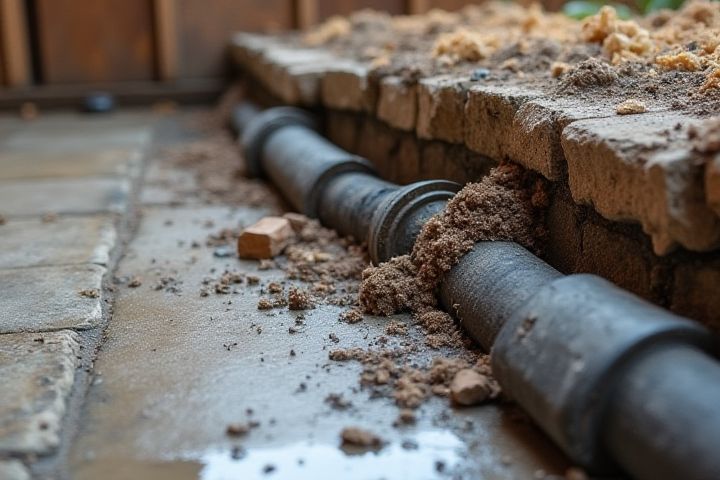
To waterproof a house basement effectively, begin by ensuring proper drainage outside the foundation; this involves installing gutters and downspouts to channel water away from the basement walls. Next, apply a high-quality waterproofing sealant to both the interior and exterior surfaces of the basement walls, focusing on any visible cracks or seams. Consider adding a sump pump to manage any potential water that may accumulate, safeguarding against flooding. Additionally, explore the installation of a vapor barrier if moisture is a common issue, as this will prevent dampness from seeping through the walls. Regularly inspect and maintain your waterproofing measures to ensure long-term effectiveness and protect your home's structural integrity.
How To Waterproof A House Basement
Identify and seal cracks.
Identifying and sealing cracks in your basement is crucial for effective waterproofing. Start by inspecting both interior and exterior walls for visible fissures or gaps, as these can allow moisture infiltration. Use a concrete patching compound to fill smaller cracks, while larger gaps may require hydraulic cement to ensure a watertight seal. After application, apply a waterproof sealant over the repaired areas for added protection against dampness and potential mold growth.
Install a sump pump.
Installing a sump pump is crucial for waterproofing your basement, effectively managing groundwater and preventing flooding. Begin by digging a sump pit, ideally located in the lowest part of your basement, with a diameter of about 18 inches and a depth of 24 inches. After positioning your sump pump in the pit, connect it to a discharge pipe that routes water away from your home, ideally at least 10 feet from the foundation. Regular maintenance, such as checking the pump and discharge system, ensures optimal performance and prolongs the lifespan of your waterproofing solution.
Improve drainage outside.
Improving external drainage is crucial for waterproofing your basement. Start by ensuring gutters are clean and direct rainwater at least 5 to 10 feet away from your home's foundation. Install a French drain system around your perimeter to effectively divert groundwater away from the basement. Consider grading your yard to slope away from the foundation, ensuring that water flows away rather than pooling near your home's base.
Apply waterproof coatings.
Applying waterproof coatings to your basement involves several critical steps to ensure long-lasting protection against moisture. Start by selecting a high-quality waterproof paint or sealant that contains ingredients such as polyurethane or epoxy, which offer superior resistance to water damage. Thoroughly clean and prepare the basement walls and floor, making sure to fill any cracks or gaps with appropriate filler before application. Once the surface is prepped, apply the waterproof coating in even strokes using a roller or sprayer, allowing it to cure fully as instructed on the product label to achieve optimal results in safeguarding your basement.
Install a drainage system.
To effectively waterproof your basement, installing a drainage system is critical. Begin by excavating around the perimeter of your foundation to expose the foundation walls adequately. Next, lay perforated drainage pipes at the base of the walls, ensuring they slope towards a designated drainage point, like a sump pit or outdoor drainage area. Finally, backfill the trench with gravel to facilitate water flow into the pipes, and seal the foundation walls with a waterproof membrane to further enhance protection against moisture intrusion.
Maintain gutters and downspouts.
Maintaining gutters and downspouts is crucial for waterproofing your basement effectively. Clean your gutters regularly, removing leaves and debris that can block water flow, ensuring that rainwater is directed away from your foundation. Check downspouts to confirm they extend at least six feet from your home, which helps prevent pooling near the foundation. By ensuring proper drainage through well-maintained gutters and downspouts, you can significantly reduce the risk of water infiltration in your basement.
Use dehumidifiers.
Using dehumidifiers in your basement can effectively reduce moisture levels, creating a drier environment and preventing mold growth. It's essential to select a dehumidifier with an adequate capacity, typically around 30 to 70 pints per day, depending on the size and humidity of your basement. Maintaining your dehumidifier by regularly emptying the collection tank or, for continuous drain models, ensuring the drain line is clear, will enhance its efficiency. For optimal results, set the humidity level to around 50% to ensure a comfortable and healthy living space in your basement.
Ensure proper grading of landscape.
Proper grading of the landscape surrounding your basement is crucial in waterproofing efforts. Ideally, the ground should slope away from the foundation at a gradient of at least 2% (or 1 inch of drop for every 12 inches of distance) to direct rainwater away. Installing gutters and downspouts that extend at least 6 feet from the foundation can also help in managing water runoff effectively. Regularly checking and maintaining this grading is vital to prevent water pooling near your basement walls, safeguarding your property from potential moisture intrusion.
Install vapor barriers.
Installing vapor barriers is an essential step in waterproofing your basement effectively. Begin by selecting a high-quality polyethylene sheet with a minimum thickness of six millimeters to ensure durability against moisture intrusion. Carefully cover the walls and floor, overlapping edges by at least 12 inches to create a continuous barrier, and secure the seams using waterproof tape. Properly sealing around any penetrations, such as pipes or wiring, is crucial; you can use caulk or sealant to ensure no moisture can escape through these gaps.
Use waterproof paint.
Applying waterproof paint to your basement can significantly reduce moisture penetration. Choose an exterior-grade waterproof paint specifically designed for damp environments, ensuring it contains mold and mildew inhibitors. Prepare the surface by cleaning it thoroughly and repairing any cracks with a suitable filler, which may improve adhesion and durability. A single gallon of quality waterproof paint typically covers approximately 300-400 square feet, allowing you to calculate the necessary quantity based on your basement's size.
